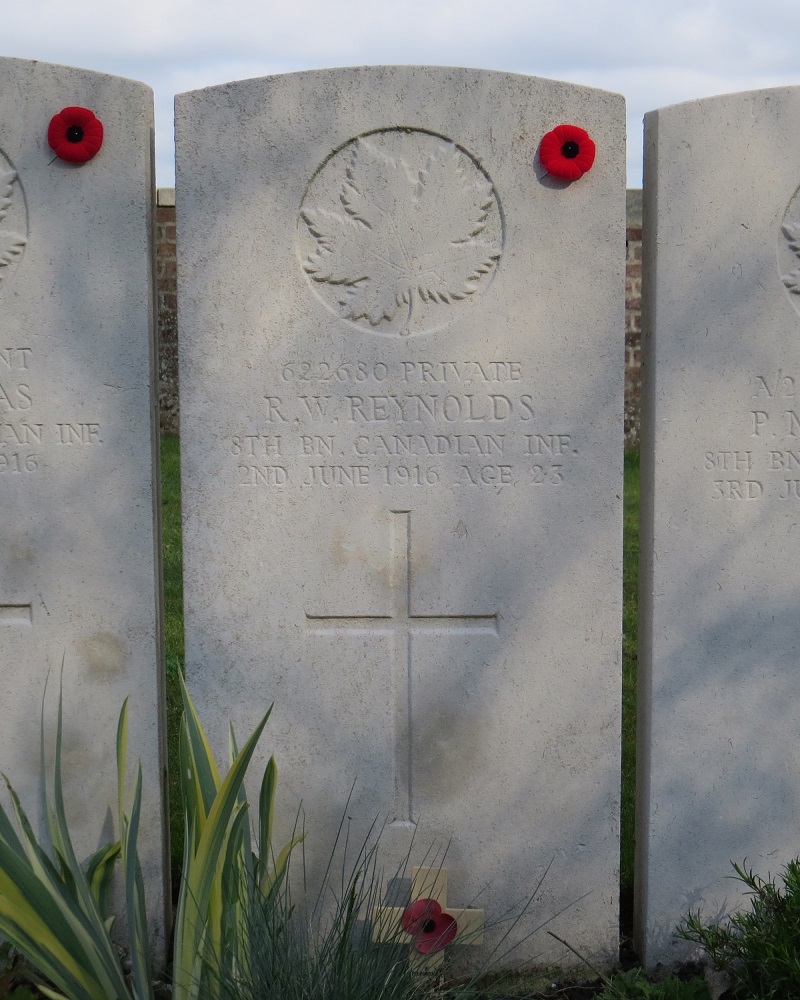Private Robert William Reynolds 622680 son of Mrs. Eliza S. Hunt, of North Acre, Caston, Attleborough, Norfolk. Native of Deepham, Norfolk, Robert left for Canada on 28 September 1905, sailing from Liverpool aboard SS CANADA, arriving in Quebec City in October 1905. Then, in 1906, Robert’s in Dauphin, Manitoba, a servant living with Mr. McMillan at Gilbert Plains.

Enlistment
Robert enlisted with the 44th Battalion, CEF in Sewell, Manitoba on 29 June 1915. A Farmer by trade. Robert stood 5 8″ tall, 160 pounds, with fair complexion, blue-grey eyes, and light-brown hair. He was Methodist.

In October of 1915, Robert forfeited two days pay, presumably being AWOL.
The 44th Battalion had been raised on 7 November 1914 and by the autumn of 1915, many men had passed through the battalion, drafts of men, who having been trained by the 44th, were then marched away to other battalions.
44th Battalion
The 44th Battalion, CEF organized in December 1914 under the command of Lieutenant-Colonel R. M. Thomson. Firstly, mobilized at Winnipeg, and recruited in Winnipeg. Then, embarked from Montreal on 1 June 1915 aboard SS GRAMPIAN.

Then, the 44th Battalion disembarked in England on 9 June 1915, with strength of 40 officers, 998 other ranks. Then, arrived in France 20 February 1916 with the 3rd Canadian Division, 9th Canadian Infantry Brigade, and reinforced by 14th Canadian Reserve Battalion. Finally, returned to England 11 February 1919, and disembarked in Canada 20 March 1919. In addition, demobilized 24 March 1919 and Colours presented by Sir Arthur Currie early in April 1919, then deposited in St. Stephen’s Church, Winnipeg, 20 April 1919. Pipe and brass bands. Finally, perpetuated by The Queen’s Own Cameron Highlanders of Canada.
Robert sailed with his battalion bound for England, from Halifax, Nova Scotia, aboard SS LAPLAND on 23 October 1915.

Then, on 30 March 1916, Robert made his Will, leaving all property to his mother, Mrs. Walter Hunt of Caston Chase near Attlebough, Norfolk. In addition, his Will forwarded to The Paymaster of the 44th Battalion at Bramshott Camp on 20 April 1916.

Then on 20 April 1916, Robert transferred to the 8th Battalion (Manitoba Regiment) and left for France the same day.
8th Battalion
Organized in Valcartier Camp September 1914. Composed of recruits from Winnipeg and from the 96th Lake Superior Regt. of the Active Militia. Commanded by Lieutenant-Colonel L. J. Lipsett.

Then, the 8th Battalion embarked Quebec City 1 October 1914 aboard SS FRANCONIA.

Then, the 8th Battalion disembarked England 14 October 1914, strength: 47 officers, 1106 other ranks. Finally, disembarked in France 13 February 1915 with the 1st Canadian Division, 2nd Canadian Infantry Brigade. In addition, reinforced by 18th Canadian Reserve Battalion, the Brass band: “Pork, beans and hard tack” used instruments of 125th Battalion, and perpetuated by The Royal Winnipeg Rifles.

Robert left Le Havre to join his unit on 13 May 1916, arriving at his unit on 20 May 1916. Robert had less than two weeks to live.
Death of Private Robert William Reynolds
On 2 June 1916, Robert killed in action. While on sentry duty in the front line trench at THE BLUFF, Ypres, at about 2:25 am., 2 June 1916, he was hit in the head by an enemy rifle bullet and instantly killed.

Private Robert William Reynolds buried in Plot V, Row A, Grave 10 the following day at Woods Cemetery.

Woods Cemetery
Woods Cemetery located 4 Km south east of Ieper town centre, on the Verbrandemolenstraat, a road leading from the Komenseweg, connecting Ieper to Komen (N336). Firstly, from Ieper town centre the Komenseweg located via the Rijselsestraat, through the Rijselpoort (Lille Gate) and crossing the Ieper ring road, towards Armentieres and Lille. The road name then changes to Rijselseweg. Then, 1 Km along the Rijselseweg lies the left hand turning onto Komenseweg. In addition, 2.5 Km along the Komenseweg lies the right hand turning onto the Vaartstraat.
Then, 900 metres along the Vaartstraat lies the left hand turning onto the Verbrandemolenstraat. Then, 400 metres along the Verbrandemolenstraat a short distance from the road is the cemetery. Finally, visitors to this site should note the 100 metre grassed access path leading to the cemetery not accessible by vehicle.
The commune of Zillebeke contains many Commonwealth cemeteries as the front line trenches ran through it during the greater part of the Great War. Woods Cemetery was begun by the 1st Dorsets and the 1st East Surreys in April 1915; it was used until September 1917 by units holding this sector, and by the field ambulances of their divisions.
The graves of the 2nd, 3rd and 10th Canadian Battalions and the London Regiment are particularly numerous. The irregular shape of the cemetery is due to the conditions of burial at the times when the front line was just beyond the wood. The views over the battlefield are extensive. Woods Cemetery contains 326 Great War burials, 32 of them unidentified. The cemetery was designed by Sir Edwin Lutyens.
The Valiant Hearts of Caston
Information regarding Private Reynolds provided courtesy of Jane Horner and her beautiful text The Valiant Hearts of Caston, printed and designed by Barkers Print & Design, Attleborough, Norfolk.

More
Please subscribe to CEFRG to be notified by email when there are new posts. Subscription is free, and your email kept confidential.
